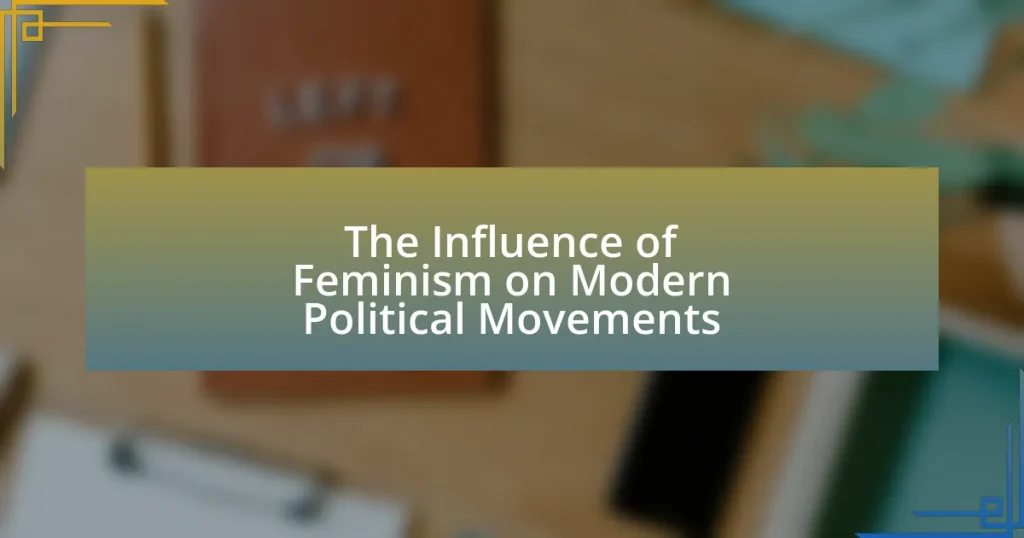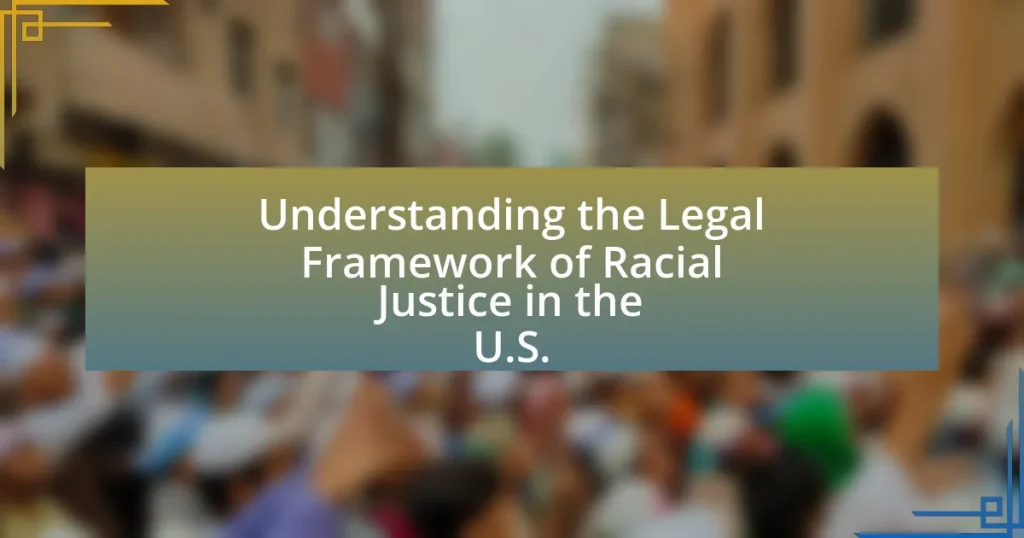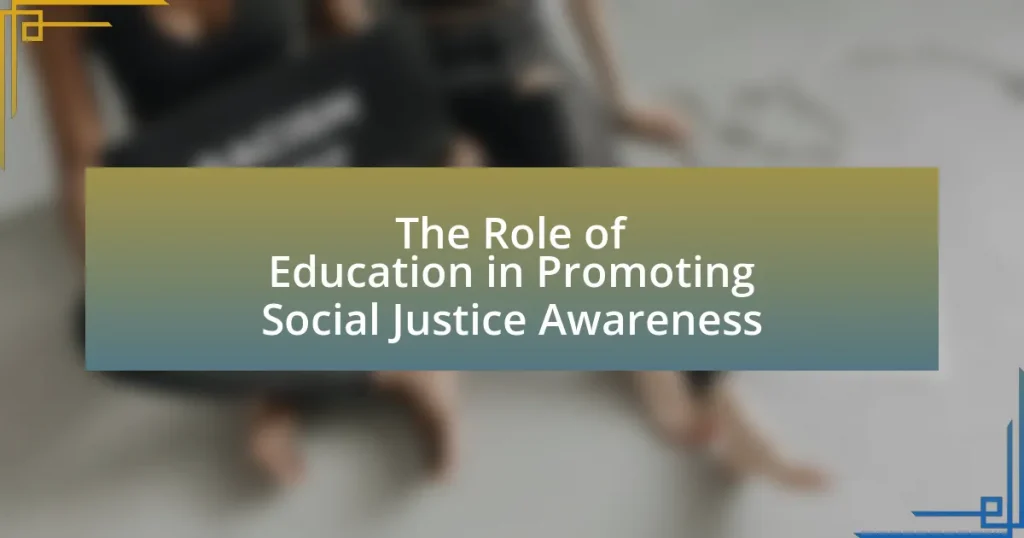The article examines the significant influence of feminism on modern political movements, highlighting its role in advocating for gender equality and social justice. It discusses how feminist principles are integrated into movements like #MeToo and Black Lives Matter, leading to legislative changes and increased representation of women in politics. Key feminist theories, such as liberal, radical, Marxist, and intersectional feminism, are explored for their impact on contemporary political ideologies and movements. The article also addresses the challenges faced by feminist movements, including backlash and underrepresentation, while emphasizing the importance of intersectionality and collaboration with other social justice movements to enhance their effectiveness.
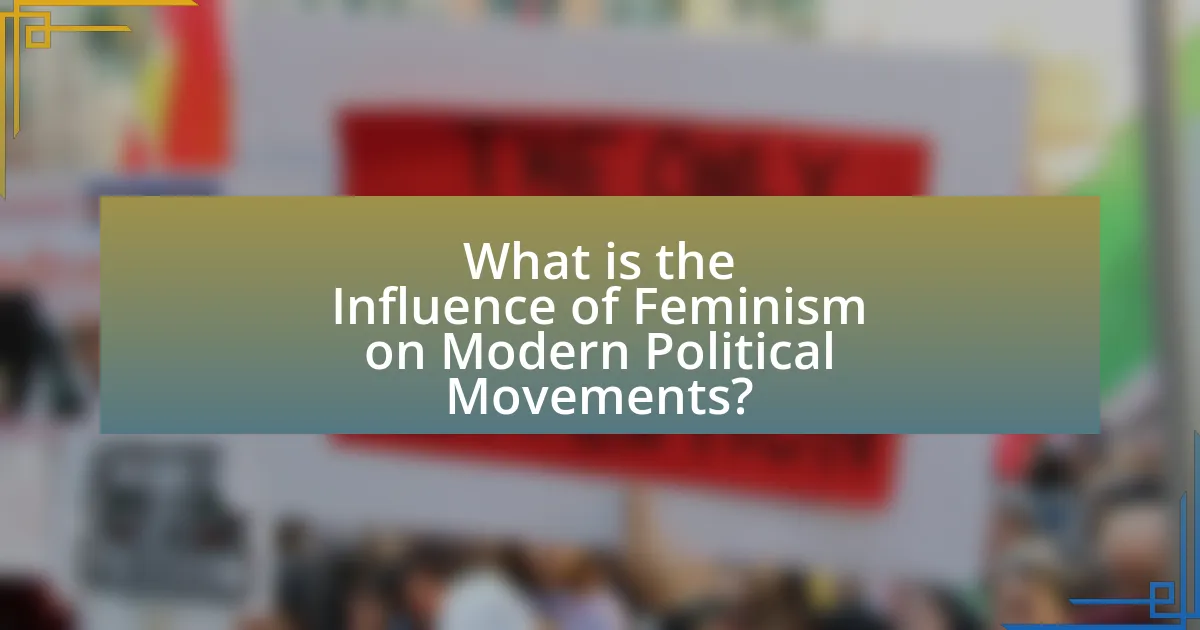
What is the Influence of Feminism on Modern Political Movements?
Feminism significantly influences modern political movements by advocating for gender equality and social justice, shaping policies and ideologies across various platforms. This influence is evident in movements such as #MeToo and Black Lives Matter, which incorporate feminist principles to address systemic inequalities. For instance, the #MeToo movement has highlighted issues of sexual harassment and violence, prompting legislative changes in workplace policies and accountability measures. Additionally, feminist activism has led to increased representation of women in political offices, with countries like Rwanda achieving over 60% female representation in parliament, showcasing the tangible impact of feminist advocacy on political structures.
How has feminism shaped contemporary political ideologies?
Feminism has significantly shaped contemporary political ideologies by introducing concepts of gender equality, social justice, and intersectionality into mainstream political discourse. These ideas have influenced various political movements, leading to the incorporation of women’s rights and gender issues into party platforms and policy-making processes. For instance, the rise of feminist movements in the late 20th century prompted political parties to address issues such as reproductive rights, equal pay, and anti-discrimination laws, which have become central tenets of modern liberal and progressive ideologies. Additionally, the intersectional approach advocated by feminists has encouraged a broader understanding of social justice that includes race, class, and sexuality, thereby reshaping leftist politics to be more inclusive and representative of diverse populations.
What key feminist theories have influenced political thought?
Key feminist theories that have influenced political thought include liberal feminism, radical feminism, Marxist feminism, and intersectional feminism. Liberal feminism advocates for equal rights and opportunities within existing political structures, emphasizing legal reforms and policy changes to achieve gender equality. Radical feminism critiques the patriarchal structures of society, arguing that systemic change is necessary to dismantle male dominance. Marxist feminism connects the oppression of women to capitalism, asserting that economic structures must be transformed to achieve true gender equality. Intersectional feminism highlights how various social identities, such as race, class, and sexuality, intersect to shape individual experiences of oppression, influencing contemporary political discourse on inclusivity and representation. These theories have collectively shaped modern political movements by challenging traditional power dynamics and advocating for comprehensive social justice.
How do feminist movements intersect with other political movements?
Feminist movements intersect with other political movements by advocating for social justice, equality, and human rights, which are common goals shared across various political ideologies. For instance, feminist movements often align with civil rights movements, as both seek to dismantle systemic oppression and promote equal treatment for marginalized groups. Historical examples include the collaboration between feminists and civil rights activists during the 1960s, where figures like Betty Friedan and Martin Luther King Jr. emphasized the importance of intersectionality in their struggles. Additionally, feminist movements have influenced labor rights movements by highlighting issues such as wage gaps and workplace discrimination, advocating for policies that benefit all workers, particularly women. This interconnectedness demonstrates how feminist movements not only address gender-specific issues but also contribute to broader political agendas aimed at achieving comprehensive social reform.
Why is understanding feminism’s influence important for modern politics?
Understanding feminism’s influence is crucial for modern politics because it shapes policies and social movements that advocate for gender equality and women’s rights. Feminism has historically driven legislative changes, such as the right to vote and reproductive rights, which have transformed political landscapes. For instance, the Women’s March in 2017 mobilized millions globally, highlighting issues like healthcare, equal pay, and sexual harassment, demonstrating feminism’s role in galvanizing political action. Recognizing this influence allows policymakers to address systemic inequalities and engage with diverse constituents effectively.
What historical contexts have shaped the relationship between feminism and politics?
The relationship between feminism and politics has been shaped by several historical contexts, including the suffrage movement, the civil rights movement, and the emergence of second-wave feminism. The suffrage movement in the late 19th and early 20th centuries was pivotal, as women fought for the right to vote, leading to significant political changes, such as the passage of the 19th Amendment in the United States in 1920. This movement established a foundation for women’s political engagement and highlighted the need for gender equality in political representation.
The civil rights movement of the 1960s further influenced feminism by intertwining issues of race and gender, leading to a broader understanding of social justice. Activists like bell hooks and Audre Lorde emphasized the importance of intersectionality, which shaped feminist political discourse and advocacy.
Second-wave feminism, emerging in the 1960s and 1970s, expanded the focus of feminism to include issues such as reproductive rights, workplace equality, and sexual liberation, significantly impacting legislation like Title IX in 1972, which prohibited gender discrimination in education. These historical contexts collectively illustrate how feminism has evolved alongside political movements, influencing policies and societal norms regarding gender equality.
How does feminism challenge traditional political structures?
Feminism challenges traditional political structures by advocating for gender equality and dismantling patriarchal systems that marginalize women’s voices. This movement promotes policies that address systemic inequalities, such as reproductive rights, equal pay, and representation in governance. Historical evidence shows that feminist movements, such as the suffrage movement in the early 20th century, successfully influenced political change by securing voting rights for women, thereby altering the political landscape. Additionally, contemporary feminist activism continues to push for reforms that challenge established norms, as seen in movements like #MeToo, which confronts sexual harassment and violence, demanding accountability from those in power.

What are the key feminist movements impacting modern political landscapes?
Key feminist movements impacting modern political landscapes include the Me Too movement, the Women’s March, and intersectional feminism. The Me Too movement, which gained prominence in 2017, has significantly influenced discussions around sexual harassment and assault, leading to policy changes and increased accountability for perpetrators in various sectors. The Women’s March, initiated in 2017, mobilized millions globally to advocate for women’s rights and social justice, emphasizing issues such as reproductive rights and gender equality. Intersectional feminism, which addresses the overlapping systems of oppression faced by women of different races, classes, and sexual orientations, has reshaped feminist discourse and policy advocacy, highlighting the need for inclusive approaches in political agendas. These movements collectively challenge existing power structures and advocate for systemic change, thereby reshaping modern political landscapes.
Which feminist movements have gained prominence in recent years?
The feminist movements that have gained prominence in recent years include the #MeToo movement, which highlights sexual harassment and assault, and the Time’s Up initiative, aimed at combating workplace harassment. The #MeToo movement, initiated in 2006 but gaining significant traction in 2017, has led to widespread discussions about consent and accountability, influencing policies and cultural norms globally. Time’s Up, launched in 2018, focuses on legal support for victims of harassment and aims to create safer workplaces. Both movements have sparked significant media attention and legislative changes, demonstrating their impact on modern political discourse surrounding gender equality.
What are the goals and achievements of these movements?
The goals of feminist movements include achieving gender equality, advocating for women’s rights, and challenging systemic discrimination. Achievements of these movements encompass significant legislative changes, such as the passage of the Equal Pay Act in 1963, which aimed to eliminate wage disparity based on gender, and the establishment of reproductive rights, exemplified by the landmark Roe v. Wade decision in 1973, which recognized women’s autonomy over their bodies. Additionally, feminist movements have successfully raised awareness about issues like sexual harassment and violence against women, leading to societal shifts and the implementation of policies aimed at protecting women’s rights.
How do these movements mobilize support and influence policy?
Feminist movements mobilize support and influence policy through grassroots organizing, advocacy campaigns, and strategic alliances. These movements engage communities by raising awareness of gender inequalities and mobilizing individuals to participate in activism, which can lead to increased public support for policy changes. For instance, the #MeToo movement galvanized widespread attention to sexual harassment, resulting in legislative changes in various jurisdictions aimed at protecting victims and holding perpetrators accountable. Additionally, feminist organizations often collaborate with other social justice movements, amplifying their collective voice and increasing their impact on policy discussions. This intersectional approach not only broadens their support base but also enhances their ability to influence legislation that addresses multiple forms of discrimination.
How do intersectionality and diversity play a role in feminist political movements?
Intersectionality and diversity are crucial in feminist political movements as they address the varied experiences and challenges faced by women from different backgrounds. Intersectionality, a concept introduced by Kimberlé Crenshaw, emphasizes that women’s identities—such as race, class, sexuality, and ability—intersect to create unique forms of discrimination and privilege. This understanding allows feminist movements to advocate for policies that are inclusive and representative of all women’s needs, rather than a singular, often white, middle-class perspective.
Diversity within feminist movements fosters a broader coalition that can challenge systemic inequalities more effectively. For instance, the inclusion of voices from marginalized communities has led to significant advancements in issues like reproductive rights, workplace equality, and violence against women. Research by the Women’s March Global in 2017 highlighted that diverse participation in feminist activism resulted in increased visibility for issues affecting women of color and LGBTQ+ individuals, demonstrating that intersectional approaches can mobilize wider support and create more comprehensive solutions.
What is intersectionality, and why is it significant in feminist discourse?
Intersectionality is a framework that examines how various social identities, such as race, gender, class, and sexuality, intersect to create unique modes of discrimination and privilege. This concept is significant in feminist discourse because it highlights that women’s experiences are not monolithic; instead, they are shaped by multiple, overlapping identities that affect their social standing and access to resources. For instance, Kimberlé Crenshaw, who coined the term in 1989, illustrated how Black women face discrimination that is distinct from that experienced by white women or Black men, emphasizing the need for an inclusive feminist movement that addresses these complexities. By incorporating intersectionality, feminist discourse can better advocate for policies and practices that recognize and address the diverse experiences of all women, thereby enhancing social justice and equality.
How do diverse voices within feminism shape political agendas?
Diverse voices within feminism shape political agendas by introducing a range of perspectives that address various social, economic, and cultural issues. This inclusivity allows for a more comprehensive understanding of women’s experiences and needs, leading to policies that reflect the realities of different communities. For instance, intersectional feminism highlights how race, class, and sexuality intersect with gender, influencing legislative priorities such as reproductive rights, healthcare access, and workplace equality. Research by the American Psychological Association indicates that intersectional approaches in feminist movements have led to more effective advocacy strategies, resulting in significant policy changes like the inclusion of marginalized voices in discussions on gender-based violence.
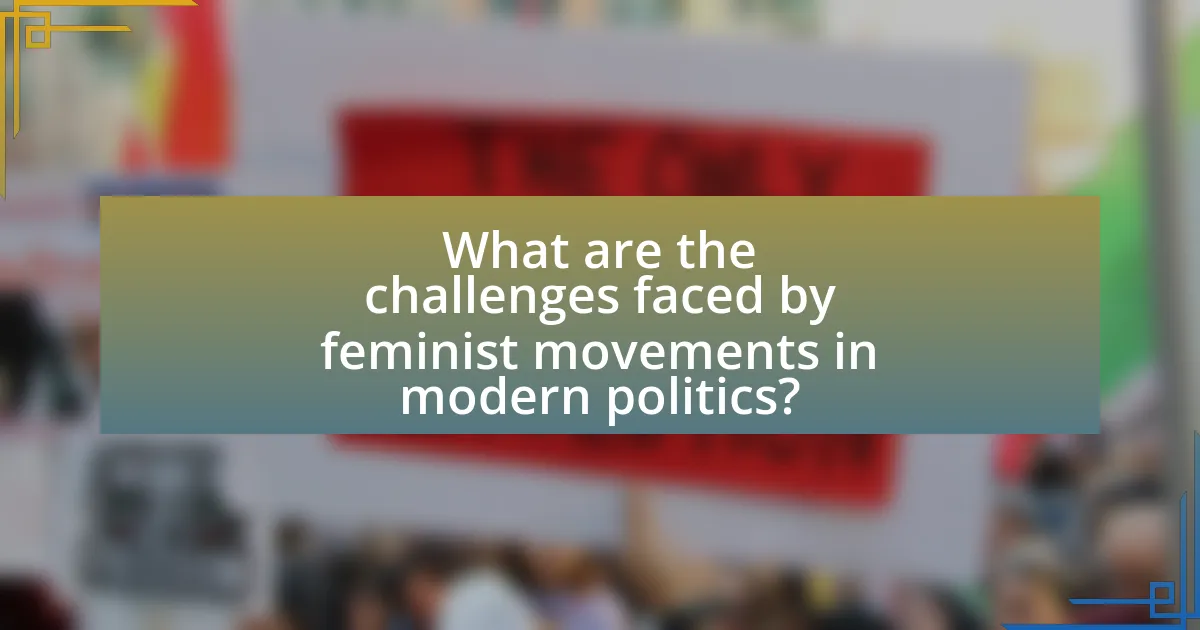
What are the challenges faced by feminist movements in modern politics?
Feminist movements in modern politics face several significant challenges, including backlash against gender equality, intersectionality issues, and political representation. Backlash against gender equality manifests through legislative rollbacks on reproductive rights and gender-based violence protections, as seen in various countries where conservative movements have gained traction. Intersectionality issues arise when feminist movements struggle to address the diverse experiences of women from different racial, economic, and social backgrounds, often leading to the marginalization of voices within the movement itself. Additionally, political representation remains a challenge, as women are still underrepresented in leadership positions, with only 26.1% of parliamentary seats held by women globally as of 2021, according to the Inter-Parliamentary Union. These challenges hinder the effectiveness and inclusivity of feminist movements in shaping modern political landscapes.
What obstacles do feminist movements encounter in political arenas?
Feminist movements encounter several obstacles in political arenas, including systemic sexism, lack of representation, and resistance from established power structures. Systemic sexism manifests in policies and practices that marginalize women’s voices and issues, often resulting in inadequate support for feminist agendas. The lack of representation is evident as women remain underrepresented in political offices, which limits their ability to influence legislation and policy effectively. Additionally, established power structures often resist feminist initiatives, viewing them as threats to traditional norms and hierarchies. For instance, a study by the Inter-Parliamentary Union in 2021 highlighted that women hold only 25.5% of parliamentary seats globally, illustrating the significant barriers to achieving gender parity in political representation.
How do societal attitudes impact the effectiveness of feminist movements?
Societal attitudes significantly impact the effectiveness of feminist movements by shaping public perception, influencing policy decisions, and determining the level of support or opposition these movements encounter. For instance, when societal attitudes are predominantly supportive of gender equality, feminist movements can gain traction, leading to legislative changes such as the passing of laws aimed at reducing gender discrimination. Conversely, negative societal attitudes can hinder progress, as seen in regions where traditional gender roles are deeply entrenched, resulting in resistance to feminist initiatives. Research indicates that in countries with higher gender equality indices, such as Sweden and Norway, feminist movements have successfully influenced political agendas, demonstrating that favorable societal attitudes correlate with increased effectiveness in achieving their goals.
What role does backlash play in the progress of feminist agendas?
Backlash plays a significant role in the progress of feminist agendas by highlighting societal resistance to gender equality initiatives. This resistance often manifests in various forms, such as political opposition, social media campaigns, and legislative rollbacks, which can galvanize feminist movements to respond more vigorously. For example, the backlash against the Women’s March in 2017, which included counter-protests and criticism, ultimately led to increased visibility and mobilization of feminist activists, resulting in a surge of women running for political office in subsequent elections. This pattern demonstrates that while backlash can temporarily hinder progress, it often serves to strengthen the resolve of feminist movements and can lead to greater advocacy and awareness of gender issues.
How can feminist movements adapt to overcome these challenges?
Feminist movements can adapt to overcome challenges by embracing intersectionality, which recognizes the diverse experiences of women based on race, class, sexuality, and other identities. This approach allows feminist movements to address the unique barriers faced by marginalized groups, thereby fostering inclusivity and solidarity. For instance, the 2017 Women’s March in the United States highlighted intersectional issues, bringing together various communities to advocate for a broader range of rights, demonstrating that a unified front can amplify voices that are often overlooked. By prioritizing collaboration with other social justice movements, feminist organizations can strengthen their impact and create a more comprehensive framework for addressing systemic inequalities.
What strategies can feminist movements employ to enhance their impact?
Feminist movements can enhance their impact by employing intersectional approaches that address the diverse experiences of women across different identities. This strategy recognizes that factors such as race, class, sexuality, and ability intersect to shape women’s lives and challenges. For instance, the 2017 Women’s March in the United States exemplified intersectionality by including voices from various marginalized groups, thereby amplifying the movement’s reach and relevance. Research indicates that movements that adopt intersectional frameworks are more effective in mobilizing support and achieving policy changes, as they resonate with a broader audience and foster solidarity among different communities.
How can collaboration with other movements strengthen feminist goals?
Collaboration with other movements can strengthen feminist goals by creating a unified front that amplifies voices and resources. When feminists partner with movements such as racial justice, LGBTQ+ rights, or environmental activism, they can address intersecting issues that affect marginalized groups, thereby broadening the impact of their advocacy. For instance, the collaboration between feminist and civil rights movements during the 1960s led to significant legislative changes, such as the Civil Rights Act of 1964, which included provisions against gender discrimination. This historical example illustrates how collective action can lead to more comprehensive policy reforms that benefit multiple communities.
What practical steps can individuals take to support feminist political movements?
Individuals can support feminist political movements by actively participating in advocacy efforts, such as attending rallies and engaging in campaigns that promote gender equality. Participation in these events raises awareness and demonstrates solidarity with feminist causes. Additionally, individuals can educate themselves and others about feminist issues, which fosters informed discussions and helps dismantle misconceptions. Supporting feminist organizations through donations or volunteer work also provides essential resources for their initiatives. Furthermore, individuals can use social media platforms to amplify feminist messages and share relevant content, thereby reaching a broader audience. Research indicates that grassroots movements, which rely on community involvement and support, are crucial for driving political change, as seen in the Women’s March and #MeToo movement, which mobilized millions globally.
How can grassroots activism contribute to feminist causes?
Grassroots activism can significantly contribute to feminist causes by mobilizing communities to advocate for gender equality and women’s rights. This form of activism empowers individuals at the local level to organize campaigns, raise awareness, and influence policy changes that directly impact women’s lives. For instance, the Women’s March, which began in 2017, exemplifies how grassroots efforts can unite diverse groups to address issues such as reproductive rights and workplace equality, demonstrating the power of collective action. Additionally, studies show that grassroots movements often lead to increased political engagement among women, resulting in higher representation in decision-making roles, as seen in various local and national elections.
What resources are available for those looking to engage with feminist movements?
Numerous resources are available for individuals seeking to engage with feminist movements, including organizations, literature, online platforms, and educational programs. Prominent organizations such as the National Organization for Women (NOW) and the Women’s March provide opportunities for activism, networking, and advocacy. Literature, including foundational texts like “The Second Sex” by Simone de Beauvoir and “Gender Trouble” by Judith Butler, offers critical insights into feminist theory and practice. Online platforms like Feminist Frequency and social media groups facilitate discussions and mobilization efforts. Additionally, educational programs at universities often include feminist studies courses that equip individuals with knowledge and skills to engage effectively in feminist activism.










